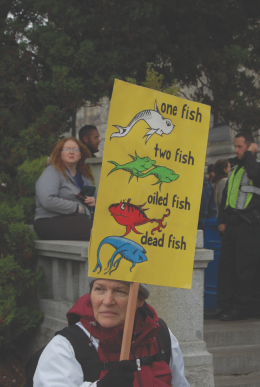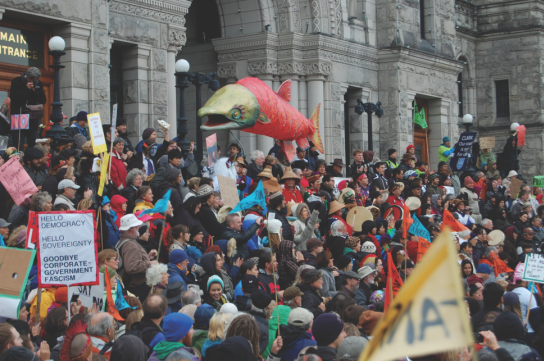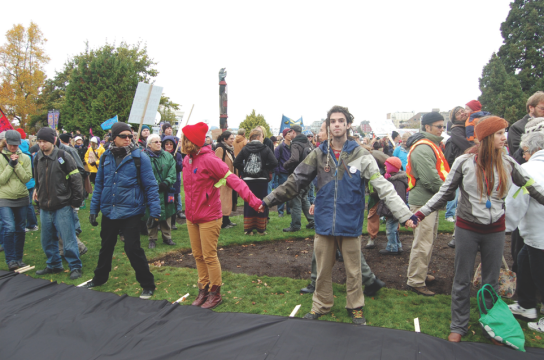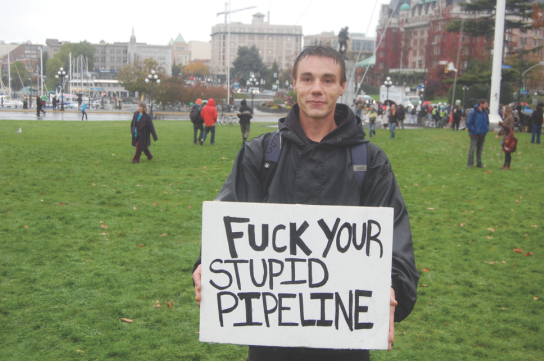Print Edition: October 24, 2012
The Defend Our Coast protest unites its members against the proposed Enbridge pipeline and expansion of the Kinder Morgan pipeline and against the tankers that would have to be introduced to the coastline if these large energy companies are successful in their bid for expansion. They are calling out the Harper government’s anti-environment campaign, demanding that First Nations rights be respected and attempting to steer British Columbia in the direction of a more sustainable future. Their message to Christy Clark and the Harper Government is simple and clear: “Our coast is not for sale.”
“I hope the pipeline doesn’t go through, because I don’t think this look suits me,” a man dressed up as death told us. He waved a sign that that said “No Enbridge,” and then disappeared, weaving through the crowds. The green lawn of the Parliament building in Victoria, BC was hidden beneath the thousands of demonstrators protesting the proposed Northern Gateway and Trans Mountain pipelines.
There’s nothing like thousands of voices screaming in unison the same message, to make you feel powerful. You could heard chanting from blocks away on the grey October morning. Clusters of police officers stood on the outskirts of the crowd, in bright yellow vests.
“Young people!” a woman in an electric scooter said to us as we passed, “thank-you for being here, you are our future!”
Up on the steps of the Parliament building, a stage had been set up, and speakers were addressing the crowd. Politicians, First Nations leaders, activists, and representatives from various labour unions stepped up to the microphone. The crowd responded deafeningly to speeches by Elizabeth May, Green Party MP, Chief Ruben George of the Tsleil-Waututh First Nations, and Maud Barlow of the Council of Canadians. You’d scream, and be unable to hear your own voice.
 UFV resident elder Eddie Gardener attended. He was happy with the speakers and the leading role of the First Nations people.
UFV resident elder Eddie Gardener attended. He was happy with the speakers and the leading role of the First Nations people.
“First Nations people were recognized for taking leadership in the movement to stop Kinder Morgan and Enbridge. The three messages that were given were: No pipelines, no tankers and no tarsands.”
Despite the rain and the feeling of winter finally breathing down our necks, people remained out on the lawn.
“The speakers were very inspirational and the songs and drumming and singing kept everyone in a vibrant mood,” Gardener said. “It consolidat[ed] their collective commitment to stop oil developments that threaten to bring great harm to the land, the seas and the air.”
All types of people—students, children, dreadlocked youth, middle-aged professionals in their heels and suits, aging hippies—were pressing against each other to hear the speakers.
The Raging Grannies were there. Greenpeace, Forest Action Network, Friends of Clayoqout Sound and No Tankers BC were there.
Groups from the Interior, from Alberta, the Northwest Territories all intermingled toting signs filled with succinct messages; the signs were angry, didactic and in many cases humorous. “How many times do the hippies have to be right before you listen to them?” a sign read bobbing through the crowd. “Hey Captain Harper, there are islands in Douglas Channel!” another one said testily.
An image of an orca giving Harper the finger paced about the masses; a giant salmon puppet took centre stage on steps of the Parliament building.
It was cold. We wandered to the edge of the crowd looking for a coffee place nearby. A group of at least 50 people trooped along the sidewalk towards us. “Saltspring has arrived!” an older man informed us. The crowd was delighted with itself, with each other – for being there, for making the effort, for caring. It was a good feeling, to know everyone appreciated you.
Civil Disobedience
The civil disobedience started at 1 p.m., with drums and chanting as a backdrop. A line of over 200 protesters advanced on the Parliament lawn, each carrying a spiked post that held a long black banner. The banner is 235 meters long, the length of the super tankers that would be introduced to the coast if the pipeline proposal proceeds. It is illegal to erect any structure on the lawn of the Parliament building.
This was the intended act of civil disobedience. The protesters would hammer the posts into the ground, sit in front of the banner, and peacefully accept any police intervention or consequences.
The day before, protesters who wished to engage in civil disobedience were offered a day-long workshop by the organisers of Defend Our Coast. There protesters were taught what peaceful civil disobedience entailed – and what the consequences were. The training, held at the University of Victoria, covered non-violent direct action, with sessions on how to ground a protest, on the principals of anti-oppression, decolonization and environmental justice. Specific scenario preparation in de-escalation, media training and the legal consequences/aspects of participating in civil disobedience were covered.
Participants were also given a thorough run-down on the nitty-gritty stuff: what an arrest would be like, what they could be fined (up to $3000), how much bail might be. Advice on what to bring—pen, paper, cameras, recorders, warm clothing, water, one piece of ID, a legal hotline number—was also given out. There were a lot of people walking around with phone numbers on their arms in case of arrest.
This day of training, according to organiser Eric Doherty, was a key part of the Defend Our Coast’s goals. “Now we’ve got a whole bunch of people—250 people—that have gone thought direct action training, and they’re going be going back to their communities and organising their own actions.”
The banner was slowly erected, as the marshals directed press and protesters who did not wish to risk arrest away. But there was no intervention from the Victoria Police force. The banner was held across the road in front of the Parliament building; the law enforcement blocked the roads but did not remove protesters from their spots.
Groups of police officers watched from the windows of the legislature building; more stood amongst the protesters, unperturbed by the excited throng. According to several officers, the organizers had contacted the local police, and informed them on the exact action that would take place.
One officer, Rob, admitted that they did not plan on intervening with the illegal activities of the protesters. He was pleased with how peaceful the rally was going.
“I think it is a great crowd, everyone is peaceful, everyone is calm, they’re getting their point across without getting too crazy, it’s great.”
Defend Our Coast organiser Eric Doherty explained that the point of the protest wasn’t at all to get arrested – it was to draw attention to the issue, and to train people in direct action. “The goal was to raise the issue of what’s threatening our coast, and threatening our climate, and we’ve done that . . . it’s about getting a whole bunch of people trained in direct action, and a whole bunch of people to show that they are willing to take direct action, and are willing to risk arrest.”
The Protestors
Rain began smattering down on participants of the rally just a little while before the formation of the banner. It came down steadily from then on. The stoic protesters bore the cold wind and rain, their spirits high.
Anna of Victoria sat in front of her graffitied tanker-banner (“tankers are for wankers”) late into the afternoon. She came prepared to be arrested.
“I’m here because I care about my environment and the people who live in it, because I love them and I’m going to stand up for them no matter what it takes.”
Dwight was a bit farther down, sitting cross-legged in a heavy-duty raincoat. “Tar sands are a disaster in the beginning, middle and the end,” he explained.
“So in Alberta the environmental mess that’s happening with the huge settling ponds and the torn up forest is a disaster. In the middle, the transportation of oil across our province, crossing rivers, into tankers, across the ocean, there’s a chance, there’s a chance for creating a big mess, and it can’t be cleaned up.”
The words on the black banner nearby him read, “Help China Turn to Green Energy: Say No to the Pipeline.” Dwight continued: “in the end, when it gets to China, and it is refined, then it gets burnt. And then we have more Carbon going into our atmosphere and that’s the last thing we need … we could cross a tipping point, and then climate change will be unstoppable.”
Looking very unruffled despite the rivulets of rain running down his jacket, Dwight said the solution is to go clean and green. “The solution is green energy and shifting our economy into clean energy and there are lots of options for that already.”
As the day ended, more people continued to write messages on the tanker-banner, white words on black.
The last messages were left on the lawn of the Parliament building for all to see: “Where’s Our Future?”; “Protect the Coast.” “Shame.”





